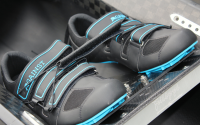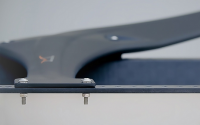The Randall Rowing Foil – The Future is Now?

Congratulations to Martino Goretti of Italy on becoming World Champion in the lightweight men’s single scull. Martino had the courage to explore all possibilities and to do what no other athlete at the 2019 World Championships or prior had done – use the Randall Foil. He is forever a World Champion, with his hard work and courage rewarded!
This article was first published in Rowtrade at the beginning of this year. With Martino Goretti of Italy making history and becoming the first rower at a World Championship, and indeed the first ever World Champion to use the foils the article is being republished as no doubt the interest in the foils will naturally increase……..
Introduction
Those more mature members of the rowing community will remember a time when cleaver blades did not exist. Come the Barcelona Olympics in 1992, some crews had made the transition from Macon to cleaver blades, including Australia’s own Oarsome Foursome. After a disappointing result in Amsterdam leading up to the Olympics, the reigning World Champions in the Coxless Four made the decision to move to cleaver blades. As they say, the rest is history!
In late 1992 I distinctly remember moving from using Macon to cleaver blades, and was staggered at how much easier they were to row with. I was equally surprised as to why any crew turned up to Barcelona using Macon blades.
The future is now?
In the years since, there has been a slow but progressive evolution of the cleaver blade with Braca, Croker and Concept 2 all selling their “smoothie” equivalent blade. If one were to row the original cleaver “big blade” back to back with these new smoothie designs, you would notice a distinct difference in the ease with which one can control blade depth and achieve maximum grip with the water. Failing this slow evolution, there has been a distinct lack of innovation until now!
School Teacher and Sydney rowing enthusiast Ian Randall may have come up with the next big thing in the evolution of rowing and boats speed. The “Randall Foil” is a lip that attaches to the top of the blade.
Testing
I have extensively tested the foils and have made the following observations (with some changes to the set up of the gate/pin):
Areas of benefit:
- Blade depth is controlled so there is far less vertical movement of the blade through the drive phase
- As a result of the above, there is far less slipping of the blade at the catch and release resulting in greater effective length and a more efficient stroke
- The foils create a platform from which the blades stabilise the boat through the drive phase. This is particularly noticeable at the catch where the rower will be able to apply more power earlier in the drive phase
- They make rowing easier. As a result, crews will be faster out of the start and faster in the second half of the race as they make it easier to row well when fatigued
- You are able to row with a significantly reduced or zero pitch on the blade face meaning the blade will perform in a more efficient and effective manner
There are a few compromises when using the foils:
- Having rowed with a foil on stroke side and no foil on bow side I can say that into a very strong head wind there is a small increase in inertia given the larger surface area traveling into the wind. Having said that, if you or your crew square early, the square blade is a far greater resistance
- In 6 kms of rowing in a single scull in extremely strong tail wind conditions with very rough water, I did have a blade catch a wave on 3 occasions. While the blade could still move through the wave, the resistance was greater than that of a standard blade. It will be important for those in small boats to row with their blades off the water on the recovery in rough conditions. For those in big boats this impact should be far less given the ease of balance in larger boats. I did not have the same issue into the head wind, I think this was because the boat speed was much slower relative to the water compared to in the tail wind, and the increased stability of the boat rowing into the wind
- The foils need to be professionally installed. As you can imagine, the foils are subjected to strong forces in and out of the boat. As such, after testing if you are to commit to these, they do need to be attached to the blades with the appropriate resins to ensure they remain intact
Verdict
I walked away from testing the foils feeling that they represent the future. Some may say this has already been tried with the original Concept smoothie and Croker also experimenting with a lip but these designs were more of a “ramp” style lip rather than the 90 degree wall that the foil represents. As a result the effect of the Randall Foil is far more profound and effective.
If you consider the development of the cleaver blade, these represent a fairly natural and logical progression in making rowing easier. With several prominent European rowing countries currently working with them, and an A finalist in the men’s single scull at last years World Championships currently trying them, the foils are only one win away from being an essential part of any successful crew’s equipment list.
In 1992 there were several crews on the podium at the Barcelona Olympics still rowing with Macon blades. Having witnessed the extinction of the Macon blade, those rowers must still wonder to this day what would have been had they been more open to change at the time.
* The Randall Foils are FISA, Henley and Rowing Australia approved
Rigging Tips:
If you are going to give the foils a go it is imperative that you make the following changes to get the most from them. Please note all these tips are very much dependent on the boat class and crew experience but these are the general guidelines…..
- You will need to reduce your blade face pitch (usually 4 degrees) by as much as 3or 4 degrees – be prepared to try different inserts to find what is optimal for you. If you do not do this, you will just wash out and any trial will be pointless
- You may need to remove any outward lay you have on the pin as this is not necessary when using the foils – in fact it may reduce their effectiveness
- You may need to increase gate height because the blade is not going as deep as usual, therefore the handle will come through the draw at a lower height
- Because the blade is more efficient/ effective you may need to reduce your oar length (outboard only) to achieve the same gearing/feel
- Be prepared to play around with your set up as the change in the characteristics of the blade and stroke are significant – be prepared to spend some time getting the most from your investment
Alastair Isherwood – Perfect Balance Rowing PTY LTD



